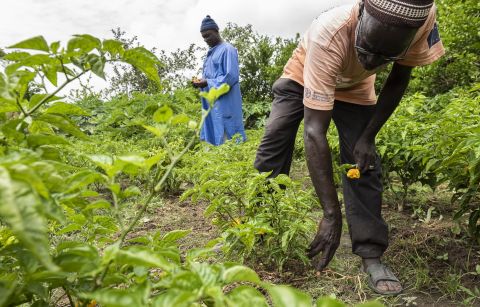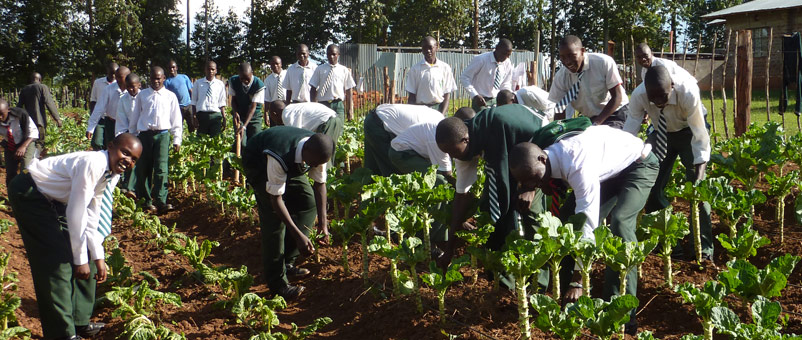Urgent climate action is needed in the food and agriculture sectors to achieve the Paris Climate Agreement goals, as food systems contribute one-third of total global greenhouse gas (GHG) emissions. Reaching net-zero GHG emissions, or carbon neutrality, by 2050 requires food systems to significantly reduce their carbon footprints. However, a major challenge lies in ensuring a just transition to net zero—a transition that wouldn’t compromise food security for vulnerable groups, particularly in the global south where most farms are small-scale.
Efforts to reduce GHG emissions often emphasise the need for major shifts in agricultural technology and practices but these can be costly, even if subsidised by governments, and disruptive to smallholders.
A complementary strategy involves reforming rural advisory services to help guide this just transition. Agricultural extension is a linchpin of local farming systems and aligning it with climate adaptation needs is critical. Extension systems should move away from their traditional technology transfer paradigm to encompass more comprehensive food system transformation approaches. In this post, we outline some of the necessary steps and challenges of such reforms.
National policies on smallholder farming as climate action
As part of the Paris Agreement, countries pledge to make nationally determined contributions (NDCs) to reduce GHGs and formulate National Adaptation Plans (NPAs). Effective climate action at the local level is a key element in pursuing these national strategies. That means strengthening the systems, institutional mechanisms and the regulatory apparatus to support and drive local climate action while minimising negative impacts on vulnerable groups—including smallholders, women and rural youth.
Thus, a critical initial phase in the just transition involves aligning countries’ NDCs and NPAs with their national agricultural sector strategies.
For agriculture, existing long-term national climate strategies aim to sustainably boost productivity—leading to increased farm income, food security and better nutrition and health. Central to these climate-smart agriculture efforts are agronomic and cultivation practices that have been at the crux of natural resource management for decades. Such approaches can be the basis for a new set of interventions for improving the resilience of smallholder systems to climate shocks.
At the same time, broader national agricultural strategies are also increasingly emphasising the need to change agronomic practices, cropping and livestock production systems and the varieties of crops grown. However, a disconnect often exists between these strategies’ fleeting references to climate action, particularly GHG reduction and on-ground implementation, impeding local climate investments. Thus, it’s important for countries to clarify the climate components of their national agricultural strategies and how they affect local farmers.
Beyond national policies, the next step is to work at the value chain level. Integrating climate action objectives into existing value chains connecting farmers to markets can showcase the benefits of adopting climate-friendly practices in cultivation and natural resource management.
Integrating climate goals into extension work plans
These initial steps pave the way for developing specific climate objectives within extension systems. Climate action must become an integral part of extension work plans—comprehensive guides for designing, executing and evaluating agricultural programs.
Climate-centric work plans must encompass the links between farmers, farmer-based organisations and local communities and their ties to various production systems’ markets. Strong support from provincial and local governments and sectoral ministries is vital, with adequate resources for extension officials, including competitive salaries, adequate transportation and continuous learning processes.
Tailored local-level extension work plans can play a key role in driving emission reduction strategies. For example, in dairy farming areas, extension could focus on reducing methane emissions through collective action—encouraging the purchase of feed additives, developing individual biogas plants and refining manure utilisation for energy. When specific commodity value chains are involved, efforts can focus on reducing emissions in transportation to markets—for example, using optimally-sized trucks and, where available, electric vehicles. Extension systems could support the repackaging of chemicals and fertilisers to reduce waste and optimise nitrogen usage in crop fields.
These localised innovations can reduce GHG emissions across landscapes and value chains while simultaneously increasing productivity and competitiveness.
Promoting innovation at the local level as climate action
Strengthening and reorienting extension systems for net-zero goals through retooling and digitalisation is also essential for integrating climate action into local knowledge systems.
This means casting a wide net for social and intuitional innovations. For example, in Central Asia, water user associations can integrate climate actions with water management goals. Women’s self-help groups in India can help extension services reach beyond farms and markets and into communities. Farmers’ organisations, focused on specific commodity value chains, can also help in adopting climate-sensitive practices and in the broader just transition, identifying emission reduction opportunities for farms and their local areas.
Empowering extension services through digital innovations
In smallholder-driven food systems, adaptation remains the key catalyst for innovations in mitigation and GHG emission reductions. Adaptation requires investments in disaster reduction, disaster management and disaster prevention operations—in which local extension systems should play a role.
Right now, however, this often isn’t the case. Early warning systems, for example, are typically run by government hydro-meteorological departments. This often leaves extension systems out of the loop when disaster strikes—for example, they may not receive information on potential threats to climate-smart crops. Integrating these related information systems can also bring digital innovations to bear on building resilience and reducing emissions.
For example, real-time monitoring systems that measure and track farmers’ activities can help in accountability and better management of local extension investments. Helping extension systems develop such simple monitoring and tracking systems—for reporting and verification of climate action and other indicators—is an important step in reforming the current extension system to work towards just transition.
A new era of extension systems driven by digital approaches—including artificial intelligence—is still in its early phases. To move forward, extension workers must be given new tools and trained in using them. Digital-friendly extension can help drive emissions reductions—for instance, by connecting farmers to carbon trading markets.
All the strategies identified above require major efforts by extension services—working with farmers and across farming systems, with farmer- and community-based organisations and with local governments. Extension systems should also help in facilitating private investments in communities to reduce the burdens of climate adaptation and mitigation on fragile public systems. Finally, documenting evidence of emerging successes and knowledge sharing across extension systems is key to transformation and just transition.
Conclusions
Advancing these new climate-friendly strategies and tools can reorient extension services towards issues beyond agriculture, including environment, sustainability, land degradation and biodiversity. If services focus broadly on climate-resilient agriculture in which both adaptation and mitigation play a key role, they can help ensure a just transition without compromising livelihoods or food security.
Of course, extension services do not operate in isolation. As they evolve to focus on food system transformation and climate change, so too must the roles of multiple actors and players—especially those in the private sector. Extension services must integrate them into climate strategies.
Finally, massive retraining with digital tools and local capacity development investments are needed to achieve a just transition in the climate change-food system space.
These ground-level extension and food system changes will be key for national governments in harmonising their agricultural strategies with their global climate commitments—and ultimately for ensuring that addressing climate change does not impose extra burdens on local farming communities.
This piece was initially published on IFPRI and has been revised to suit Farming First’s editorial guidelines.




